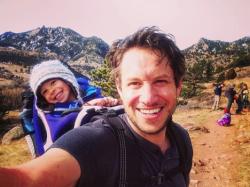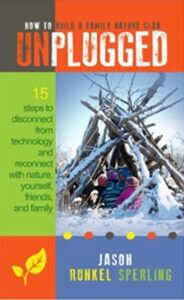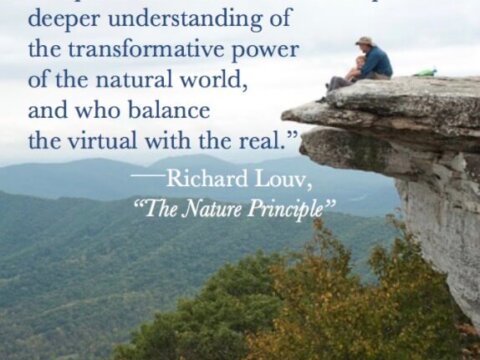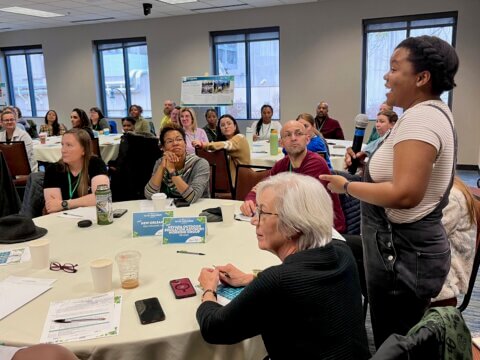SMALL STEPS, BIG FUTURE: the Profound Experience of Starting a Tiny Family Nature Club

Photo Credits: Jason Sperling
It’s 10:40 AM.We’re out on a frozen pond in the middle of a winter wonderland. It’s only 16 degrees but the children are dressed well and staying warm, passing a hatchet around.
They’re following safety practices and oversight from parents – and one by one taking swings at the ice.
The hatchet is passed to the next child. More swings. And then… They break through the ice! “Water!” “Water!” “Water!” “Water!” They scoop at the slush in the hole like this is an oasis in a desert.
Eventually, our family nature club leaves the prized hole and journeys to other frozen ponds, exploring for hours in this winter wonderland.
After I read Richard Louv’s book Last Child in the Woods, I was eager to start a family nature club. But the thought was overwhelming. So I didn’t do anything. Years later, I spotted the book on my nightstand and it occurred to me– why not start small?
I began my family nature club hesitantly with just a few families from my daughter’s kindergarten class. We met infrequently. Our outings were limited to locations and activities that I was familiar with. Yet, I soon learned that every event enriched our lives. And so I kept at it.
The experiences of our club have been remarkable. On one hike to the summit of a nearby mountain, we spotted a nest high above in an evergreen and we formed a human ladder to give the kids a chance to peer into the secret world of birds.
The children waited patiently and in wonder. When it was my daughter’s turn, she climbed carefully up the human ladder to peer into a bird’s nest held in the embrace of the evergreen.
 This moment – of all along our hike to the summit– punctuated what nature has to offer.
This moment – of all along our hike to the summit– punctuated what nature has to offer.
The children have been bathed in the wonder of the world teeming with plants and animals. They have enjoyed the opportunity to take manageable risks and build their bodies. They have strengthened interpersonal skills, empathy and trust. And they have been engaged fully.
Today, almost a year after our first outing, our family nature club has grown to over 30 families and our events regularly draw dozens of members.
I organize events every week that range from nature walks, summit hikes, mountain biking, boating, rock climbing, (this summer we’ll be backpacking!), and my favorite: unstructured nature play where the children lead and we adults follow and support.
As a father, I am proud to see my children and those of friends growing in so many ways.
They are growing connected with themselves, their families, their community, and nature. The families in our club are grateful for the profound experiences that seem to transpire on every outing. I am in awe. And I believe this isn’t just because of our group or my efforts. It is nature.
5 tips to get your own family nature club up and running
Starting a family nature club can be more manageable than it first seems. To start small, make a simple plan that will allow you to have your first event this week, or as soon as possible. Here are 5 tips to help you start:
- Define your purpose – use the 5Ws to quickly identify your purpose that will guide your efforts: Who do you want to be in your club? What kind of activities will you do? When will you do them? Where will your activities take place? Why are you doing this?
- Solicit members – reach out to who you want to be in your club. Tell them your purpose and see if they’re interested. If you are new to your area and don’t know anyone, set up a group on Meetup.com and people will find you.
- Design your event – decide the first or the first few activities and locations for your events. Visit locations before the event. If you’re stuck on ideas, research the activities of other similar groups. Write up a description for your event, including where and when to meet, what to wear, and a summary of what you’ll be doing.
- Get it the calendar – post or send the description of the event to your members so they can put it on their schedule and know what to expect. A few days before the event, send out reminders. Be sure to provide your contact information in case of questions.
- Lead the group – when members show up at your event, lead introductions, review the intent of the day, and then guide the activity. Don’t worry if you have little or no experience leading events, practice is a great way to learn!
These steps will get you up and running. You can tune and improve your club slowly as you go. Good luck!
Nature Clubs for Families Took Kit provides worksheets, templates, examples, and more resources for getting your club up and running.
Nature Clubs Directory connects you with existing clubs and leaders around the world for support in starting your own club.
C&NN’s Family Nature Club Leaders Facebook group provides ongoing support and inspiration.
-
Network News
Earth Day: Young leaders advocate for change
-
Feature
Nature photographer Dudley Edmondson has a vision for the representation of Black and Brown faces in the outdoors
-
Richard Louv
EARTH MONTH: You're part of the New Nature Movement if....
-
Voices
Placemaking: How to build kinship and inclusive park spaces for children with disabilities
-
Network News
Children & Nature Network founders release report on global factors influencing the children and nature movement






